Leucopaxillus mushrooms can grow up to 16 inches wide and are among the largest mushrooms in North American forests. These impressive fungi are often pure white or cream-colored and really stand out due to their size. Many of them also have a very impressively disgusting smell. Leucopaxillus mushrooms are not toxic and, therefore, edible, but few people forage them due to their smell and bland to bitter taste.
- Scientific Name: Leucopaxillus
- Common Names:
- Habitat: On the ground in leaf or needle litter
- Edibility: Edible but not choice
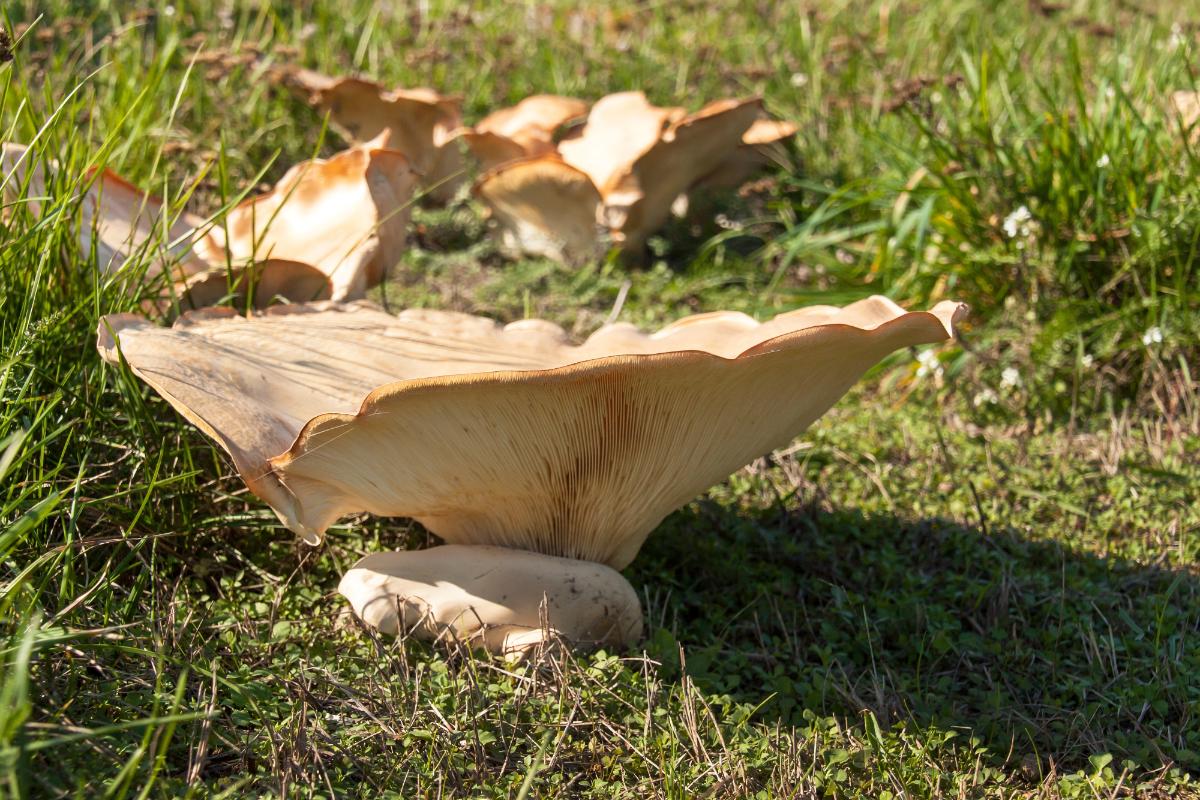
Jump to:
- All About Leucopaxillus Mushrooms
- Leucopaxillus Identification
- Common North American Leucopaxillus Mushrooms
- Leucopaxillus Mushroom Lookalikes
- Edibility of Leucopaxillus Mushrooms
- Medicinal Properties of Leucopaxillus Mushrooms
- How Leucopaxillus Mushrooms Resist Decay
- Common Questions About Leucopaxillus Mushrooms
All About Leucopaxillus Mushrooms
Leucopaxillus mushrooms belong to the family Tricholomataceae. The genus Leucopaxillus was first described by Finnish mycologist Petter Adolf Karsten in 1879. The name Leucopaxillus comes from the Greek words “leuco” meaning white, and “paxillus,” referring to a small stake or peg. This roughly translates to white peg mushrooms.
Species within this genus are characterized by their typically large, fleshy fruiting bodies, which can range from 2 to 12 inches in cap diameter. Many have very distinct and foul smells.
While not commonly eaten, some Leucopaxillus species have been traditionally employed in folk medicine. For instance, Leucopaxillus giganteus, also known as the giant leucopax or giant funnel, has been used in traditional Eastern European medicine for its potential antimicrobial properties.
Species in this genus are saprotrophic and may also form mycorrhizal associations with trees. Leucopaxillus species decompose leaf litter and woody debris on the forest floor.
Many species are known to form fairy rings or arcs in forests and grassy areas. These circular patterns of fruiting bodies can sometimes reach impressive sizes, with some documented cases extending over 30 feet in diameter. This growth pattern occurs as the underground mycelium expands outward from a central point over many years. It produces fruiting bodies at the expanding edge of growth, making the ring wider each year.
Leucopaxillus mushrooms have been studied for their production of bioactive compounds. For example, Leucopaxillus albissimus has been found to produce leucopaxin, a substance with antibiotic properties.
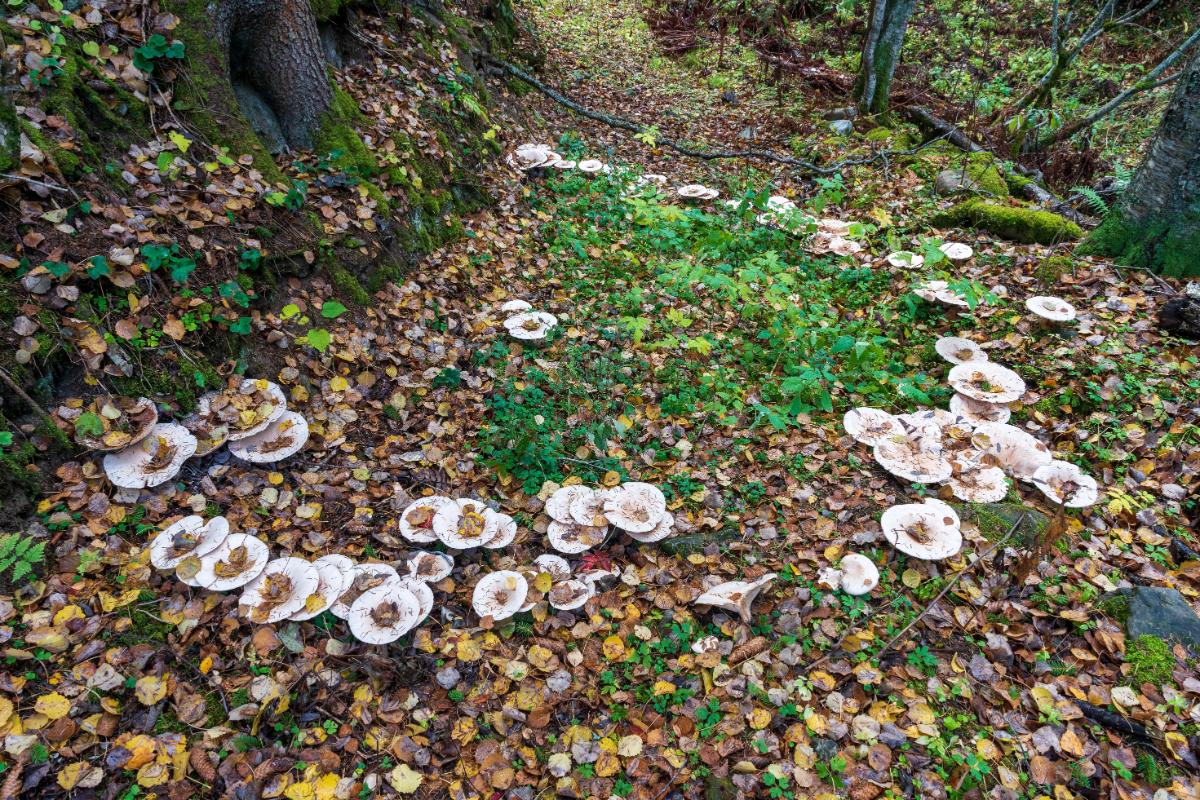
Leucopaxillus Identification
Season
Season varies by species; most fruit in fall or early winter on the west coast.
Habitat
Leucopaxillus species grow across North America. These mushrooms are saprotrophs, meaning they decompose organic matter in the forest, meadow, pasture, or lawn. Their unique antibacterial properties allow them to persist longer than most mushrooms, which might make them appear more common than they actually are. They grow in the woods, either scattered individually or forming distinctive rings or arcs on the forest floor.
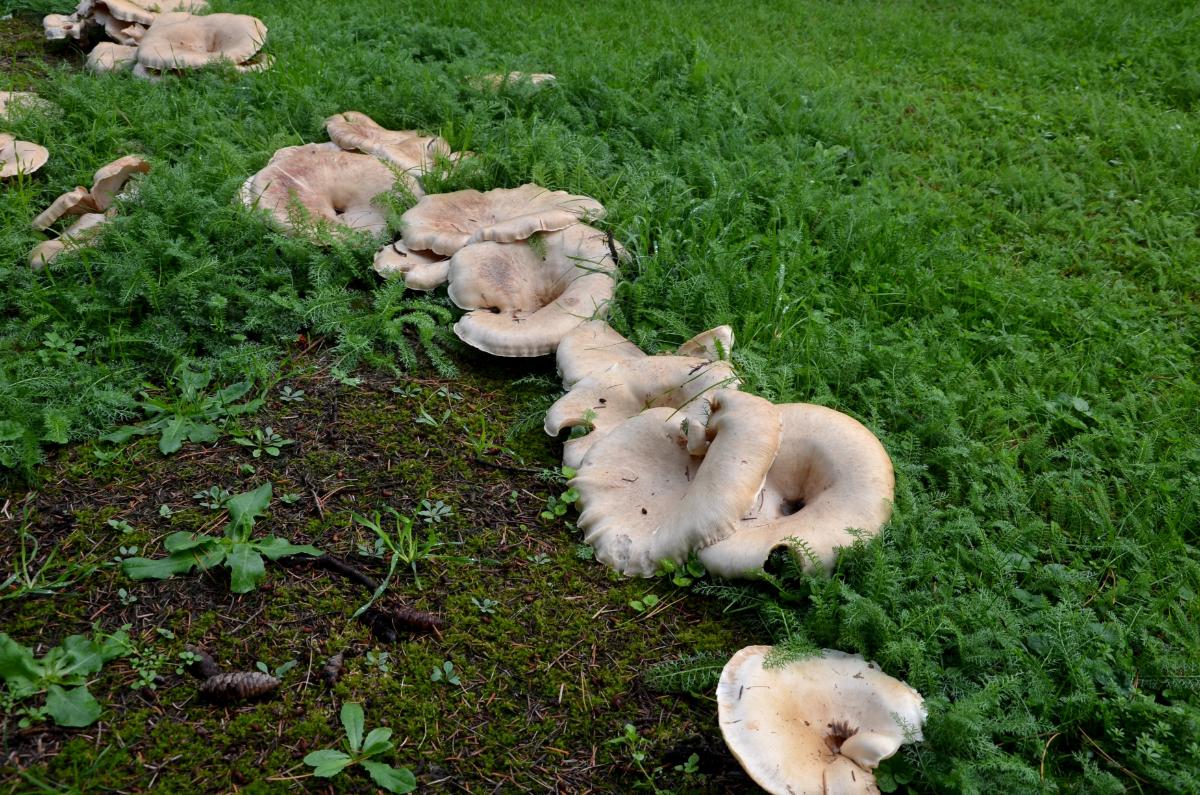
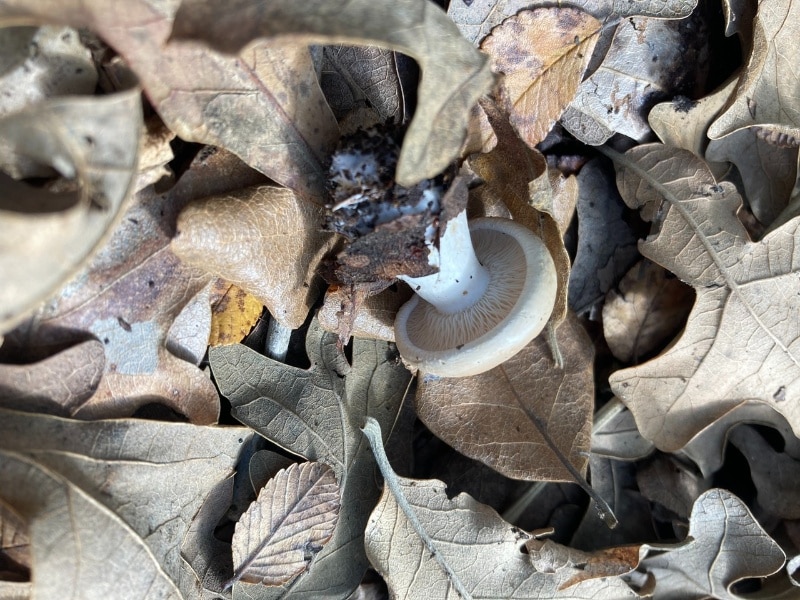
Identification
Leucopaxillus have dry, smooth (often velvety) caps with rolled under edges when young. Their gills are white to yellowish and can be separated as a complete layer from the cap. You can literally detach the gills intact from the cap. You cannot do this with many mushrooms, making it a key identifying feature for this species.
The stem is typically sturdy and often has prominent white mycelium at the base. This is also a key feature. Most mushrooms do not have piles of mycelium attached to their stem base. Many species have a distinctive mealy or coal tar odor — a strong smell!
Key identifying features include:
- Dry, convex to depressed caps
- White or yellowish gills that run down the stem
- Gills that are easily separated from the cap
- Thick stems with prominent mycelium at the base
- Notably tough flesh that resists decay
- White spore print
- Grows from the ground (saprotrophic) in leaf litter, fields, lawns, woodlands
- Tendency to grow in large scattered groups and fairy rings
- Strong mealy or coal tar odor (not for all species)
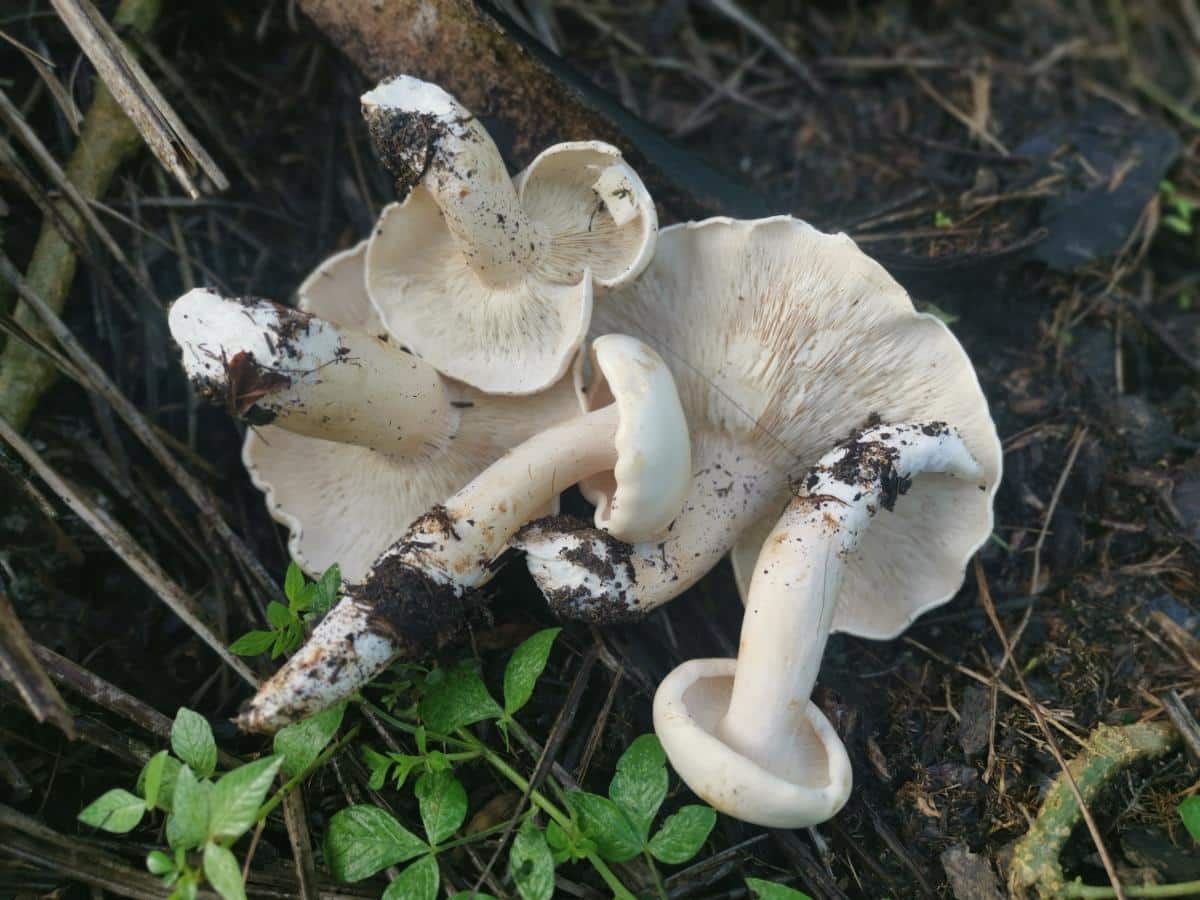
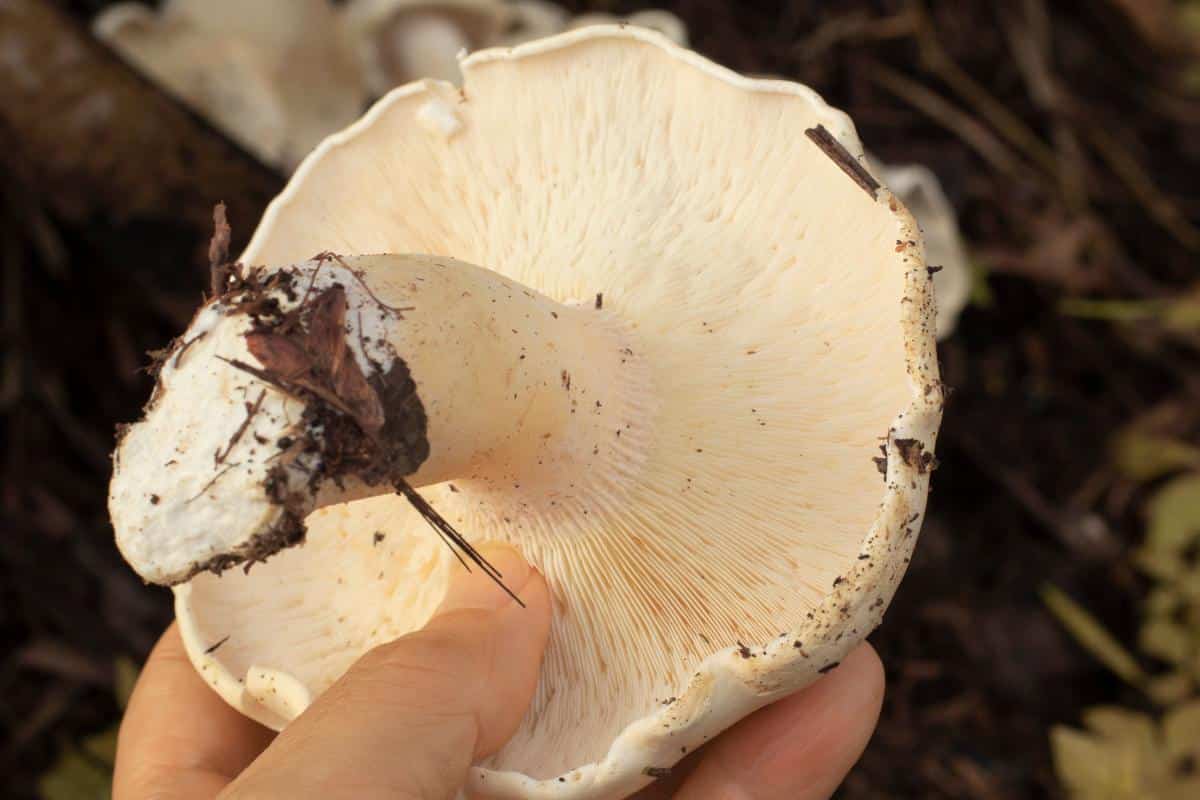
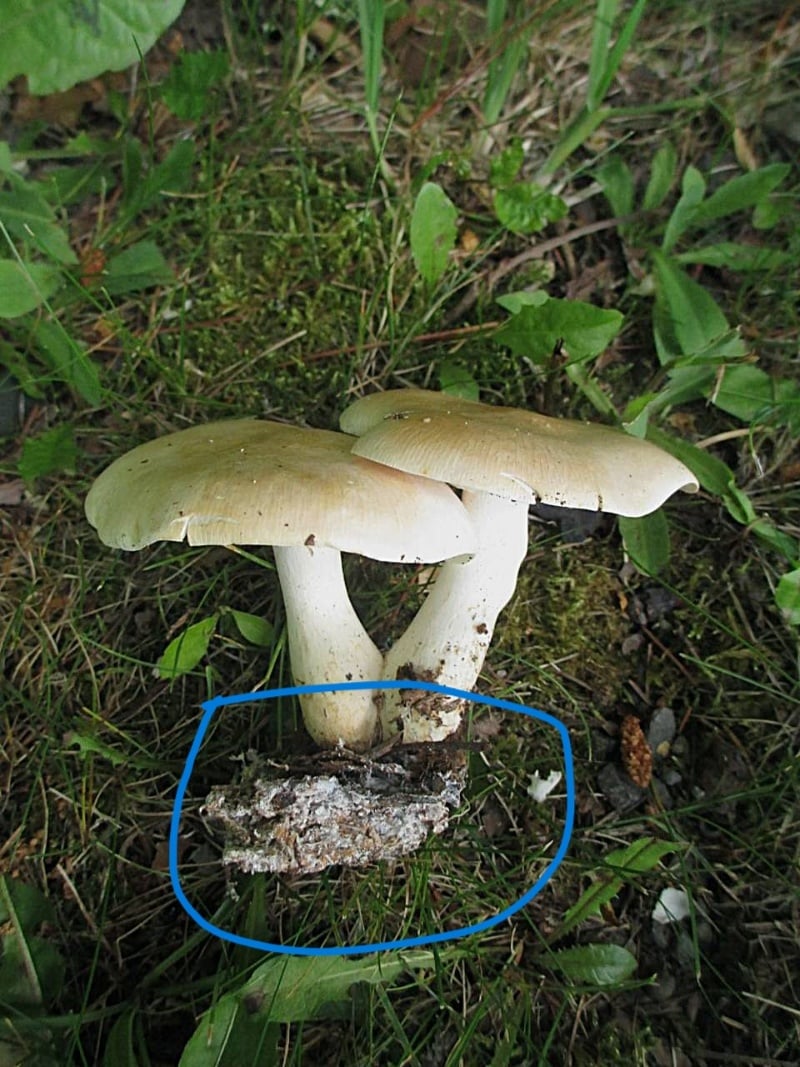
Common North American Leucopaxillus Mushrooms
Leucopaxillus laterarius
The cap of L. laterarius typically measures between 2 to 6 inches in diameter. It is rounded when young and gradually flattens with age. It often develops a slight depression in the center. When it is young, the cap is whitish to beige and then fades as the mushroom matures. The cap is usually slightly fuzzy when young, but not always.
The gills are closely spaced and white to cream-colored. With age, they may turn yellowish or brownish. The gills are slightly decurrent, running slightly down the stem. The stem measures about 1 to 3 inches long and is the same color as the cap. It may be a lighter shade towards the base. The stem might be smooth or covered with very fine, fuzzy hairs. The flesh is dense and white and does not change color when cut or bruised. This species smells strongly and is either mealy or like coal tar (like burnt chemicals).
Leucopaxillus laterarius is primarily found in the eastern and central United States and Canada. This species prefers deciduous and mixed forests and grows in association with hardwoods. It typically fruits in late summer to fall. It often appears in scattered groups or sometimes in fairy rings. These mushrooms grow directly from the ground. They often grow near the base of trees or in areas with accumulated leaf litter.
This species looks identical to Leucopaxillus albissimus and is hard to differentiate. L. albissiumus usually only grows with conifer trees, though, so tree species is one way to tell them apart. This may or may not be accurate, though, as there are reports of L. albissiumus growing with hardwoods and of L. laterarius growing with conifers. However, in general, you can use this to differentiate species.
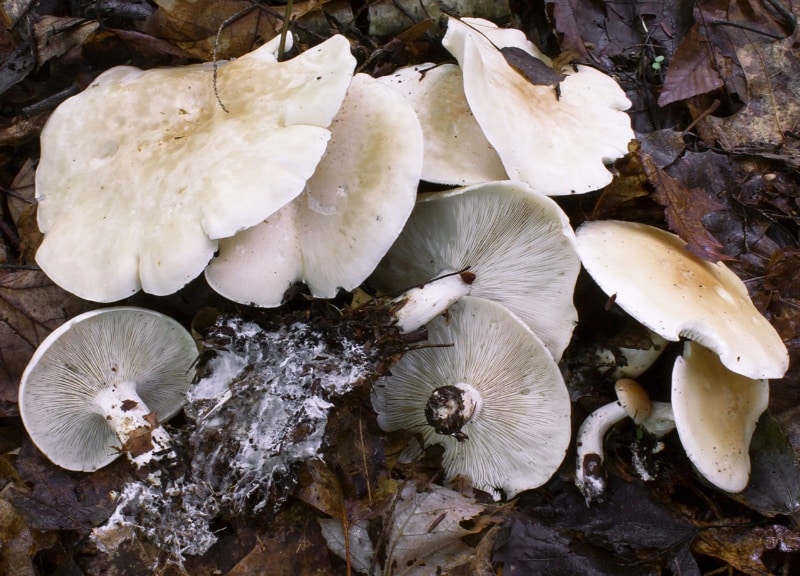
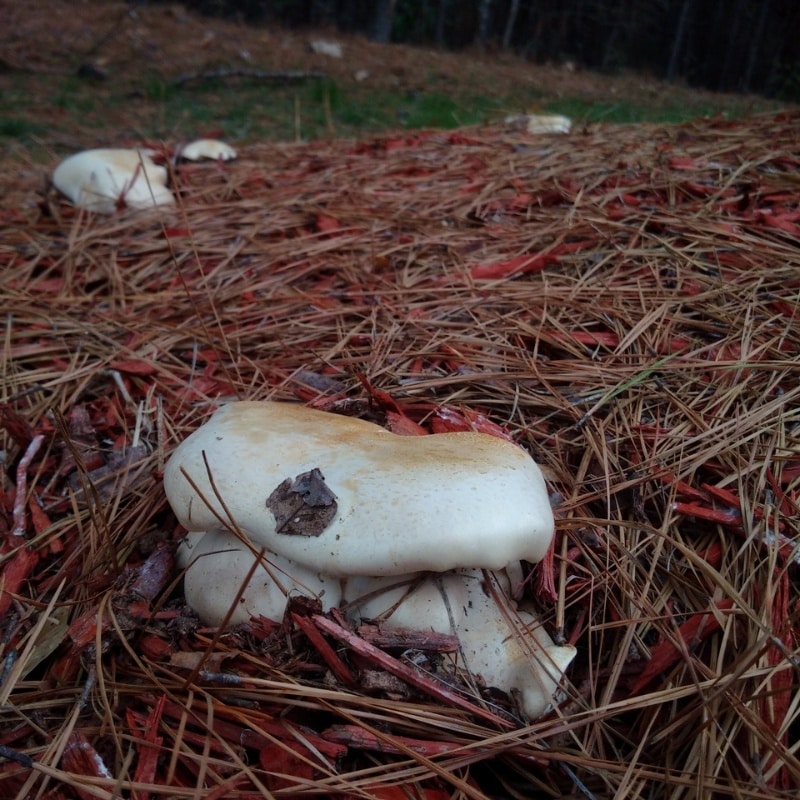
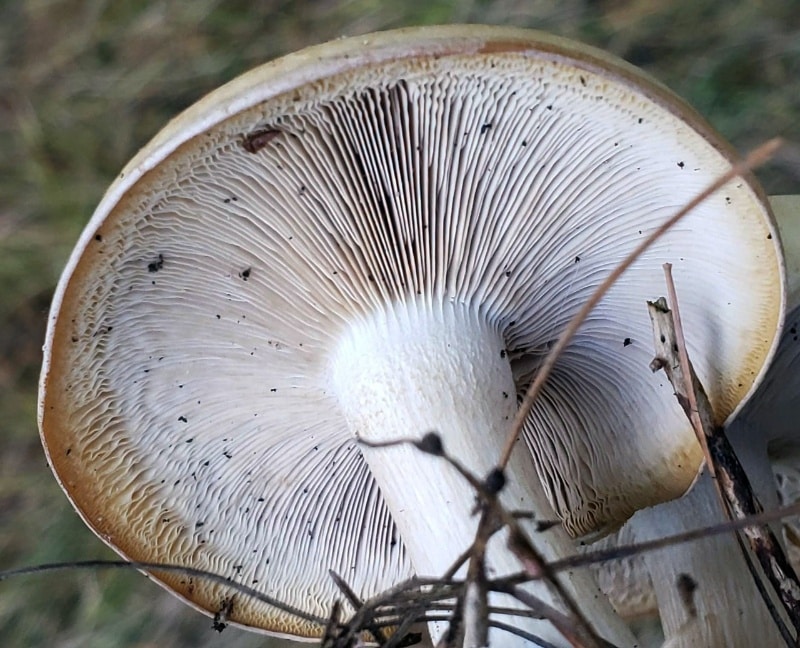
Leucopaxillus tricolor
The cap of Leucopaxillus tricolor measures between 2 to 4 inches in diameter and has a rounded shape when young, which gradually flattens out as it matures. The cap’s surface is smooth and dry. The cap is brown to chestnut colored.
The gills are closely spaced and attached to the stem, either by running slightly down it (decurrent) or meeting it squarely (adnate). The gills are pale yellow and develop a slight pinkish tinge when the mushroom is dried. The stem is solid and sturdy, measuring about 1.5 to 3 inches in length. It is white, smooth, and swollen in the middle.
A key distinguishing feature of L. tricolor is its smell. It has a strong coal tar (burnt medicinal) odor that is very noticeable. The flesh of this mushroom is white and does not change color when cut or bruised.
Leucopaxillus tricolor is widely distributed across eastern North America but is most common in the southeast. The mushroom fruits in late summer and autumn. It grows on the ground in association with hardwood trees. It typically fruits in small groups or scattered individuals rather than in large clusters.
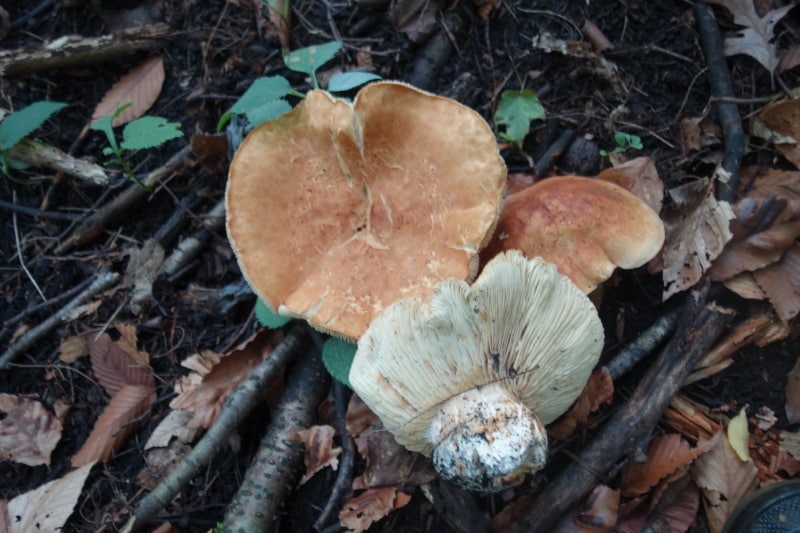
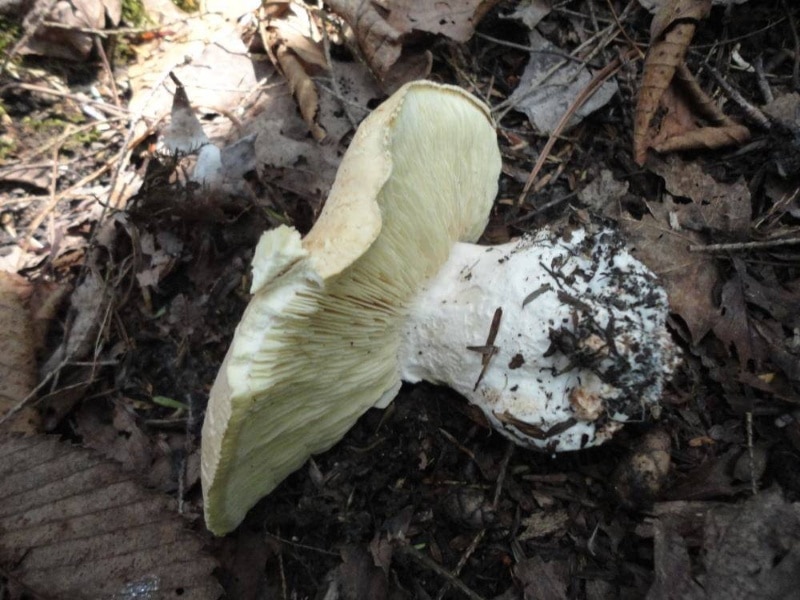
Leucopaxillus gentianeus
Leucopaxillus gentianeus, commonly known as the bitter brown leucopaxillus, has a large, robust fruiting body. The cap of this mushroom ranges from 2 to 8 inches in diameter. When young, it is rounded with rolled-under edges but flattens out with age. It has a smooth, very soft texture and is reddish-brown to orange-brown when young. At this point, separating from other Leucopaxillus species is pretty straightforward based on the cap color. But, with age, the color fades to buff, and it looks like every other species in the genus.
The gills are closely spaced, decurrent (running down the stem), and white to cream-colored. The stem is 1 to 3 inches in length and white and solid. It may become brownish when handled or with age.
The flesh of the mushroom is white and does not change color when cut. This mushroom has an intensely bitter flavor. It smells very mealy.
Leucopaxillus gentianeus is found in coniferous forests or mixed woodlands. It grows in association with conifers and decomposes the tree’s needle litter. This species grows on the ground, sometimes in clusters but more commonly as scattered individuals, in small groups, or as a fairy ring.
This species is widespread and most common west of the Rocky Mountains, but there are reports of it on the east coast. The mushroom typically fruits in late summer and autumn.
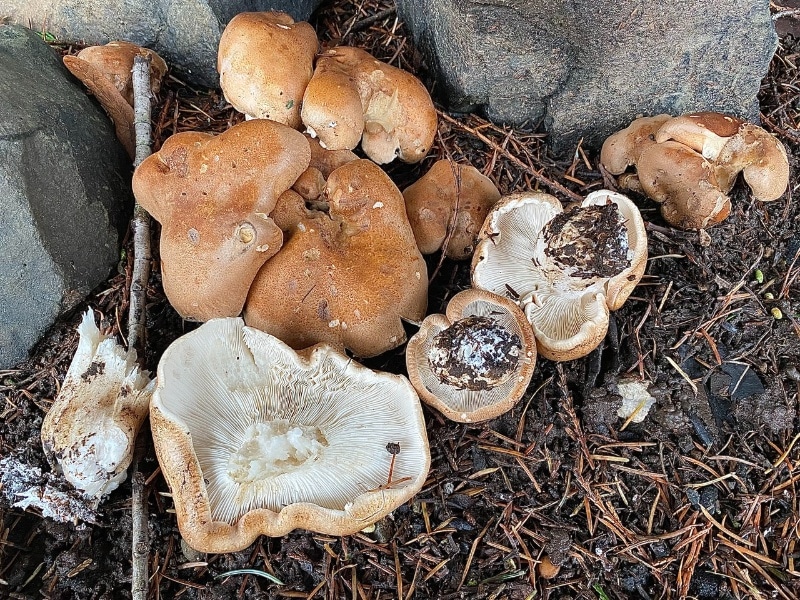
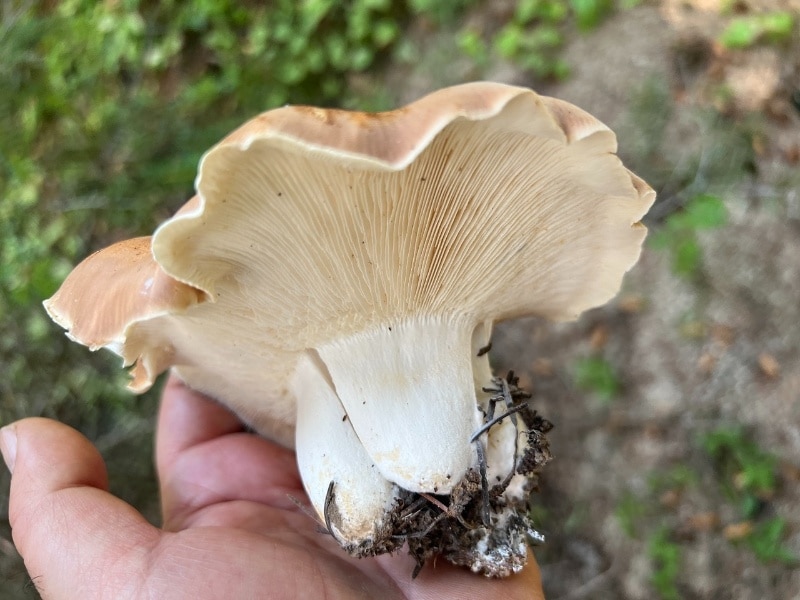
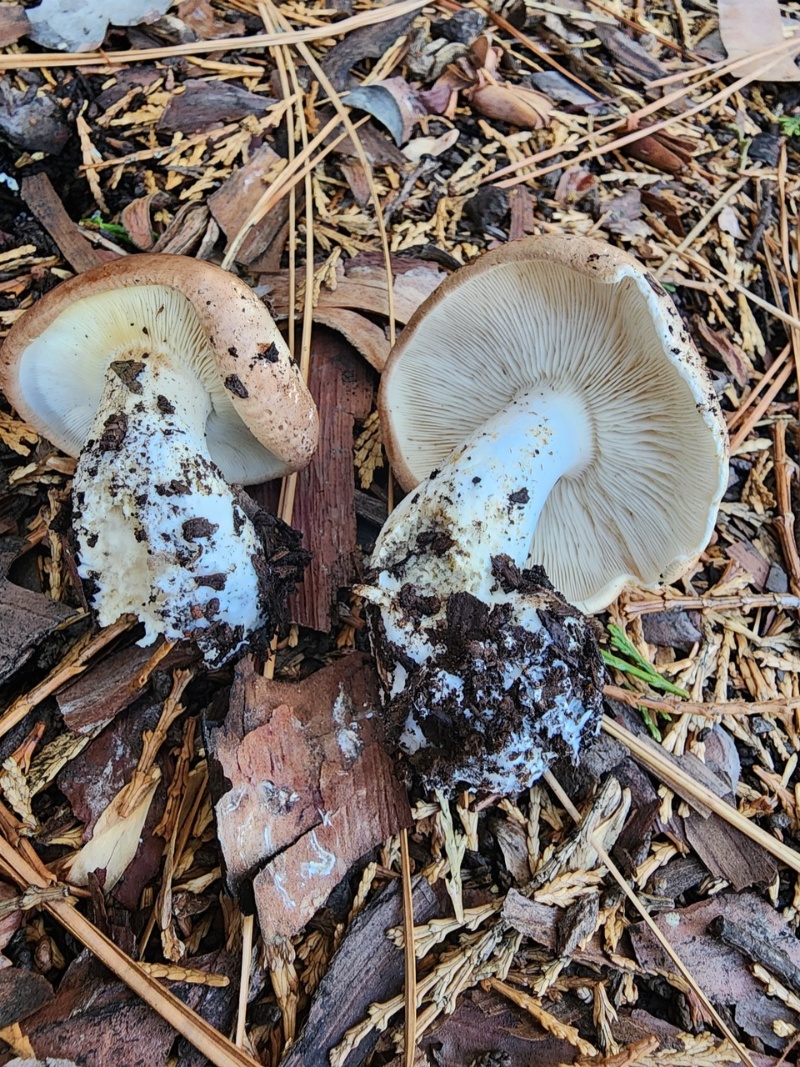
Leucopaxillus albissimus
The Giant White Leucopax or the White Leucopax can grow to impressive dimensions, often reaching 4 to 8 inches in diameter. The cap is whitish to buff to tan, and it develops brownish tinges near the center with age. It starts with a rounded shape when young and gradually flattens out as it matures. It sometimes develops a slight depression in the center. The surface of the cap is smooth and dry, with a fine velvety texture.
The gills are closely spaced and run down the stem (decurrent). They are the same bright white color as the cap but turn brown with age. The stem measures 2 to 4 inches in length. It’s solid, sturdy, and is the same color as the rest of the mushroom. The stem bruises light brown at the base when handled. It usually has a mealy or foul smell, though it may also not have a distinctive odor. The flesh is white and firm and does not change color when cut.
This species primarily grows with conifers, though it may also be in mixed forests. It grows on the ground and often forms fairy rings or arcs, where multiple fruiting bodies appear in a circular or semi-circular pattern.
This mushroom is widely distributed across North America but is more common in the Pacific Northwest and California. It fruits from late summer through fall or in winter in the western states.
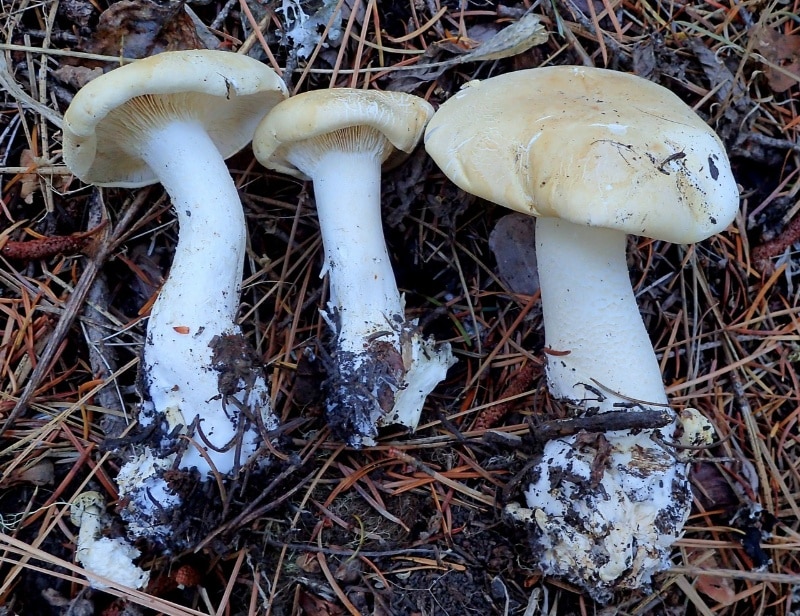
Giant Funnel (Aspropaxillus giganteus, formally Leucopaxillus giganteus)
The cap of this mushroom can grow to 4 to 20 inches, making it one of the largest mushrooms in its genus. The cap starts out rounded with a rolled under edge. But it gradually flattens and becomes funnel-shaped as it matures. Its color ranges from white to pale cream. It sometimes develops light brown or buff tones, especially towards the center. The surface of the cap is smooth and often develops cracks or scales as it ages.
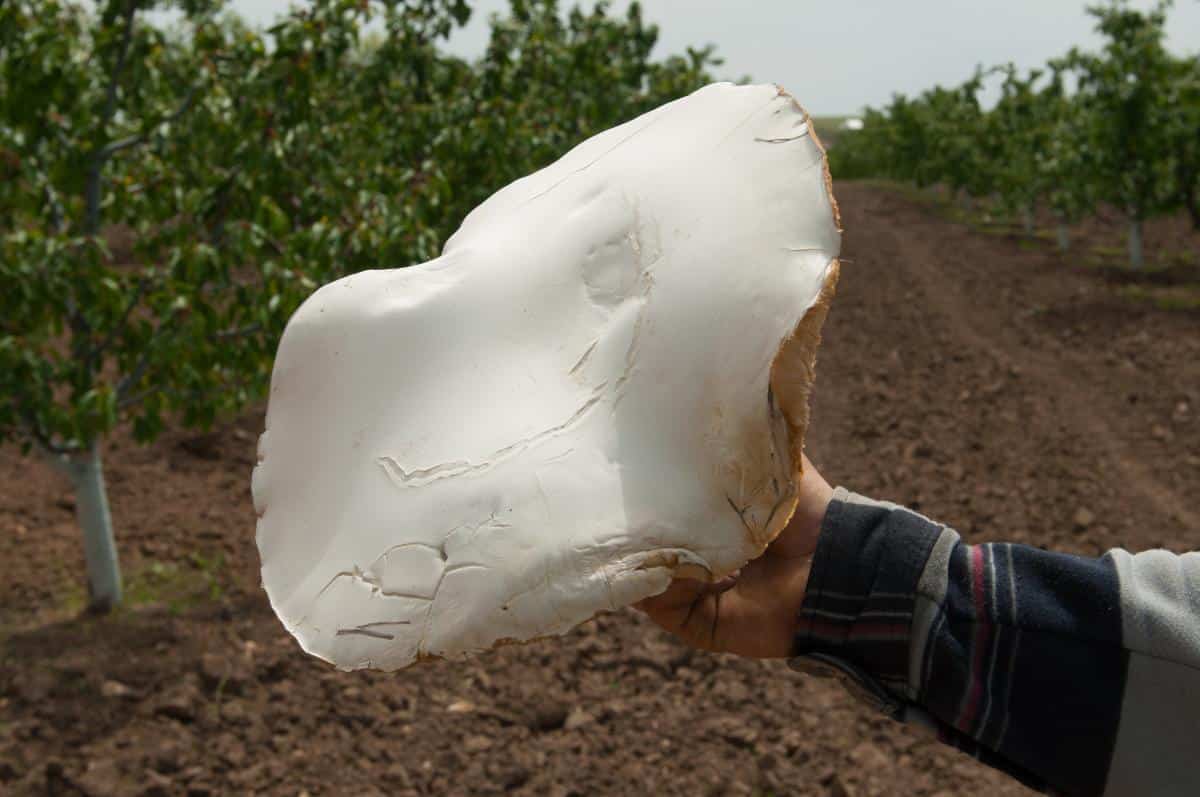
The gills of this mushroom are closely spaced and run down the stem (decurrent). They are white to cream-colored. The gills may develop a slight pinkish or buff tinge as the mushroom matures. The stem is short and stout in proportion to the cap, measuring about 1 to 3 inches tall. It’s solid, white, and often slightly off-center. The stem is covered in thin, reddish-brown fibers.
The smell of the mushroom has been described as similar to fish meal or a starchy odor. People have also described the taste and smell of the mushroom as either mild and pleasant or disgusting. The flesh is firm and white and does not change color when cut.
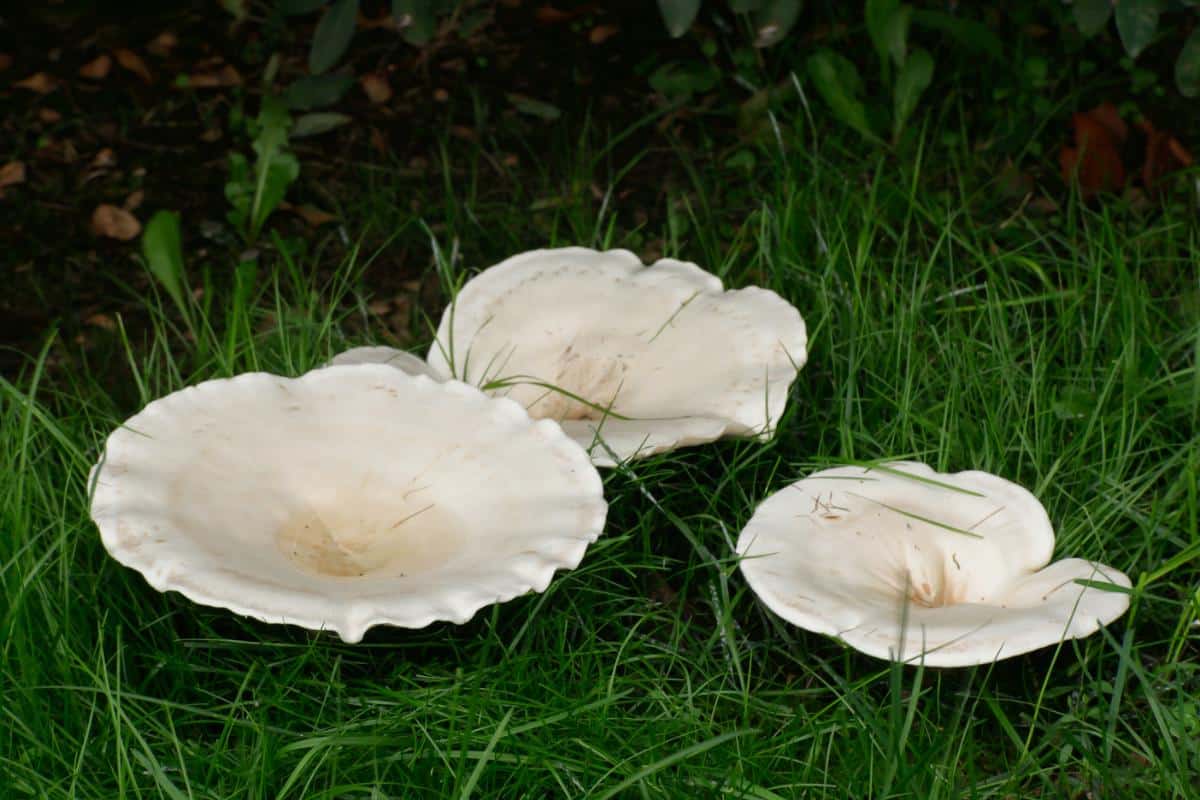
The giant funnel is commonly found growing on the ground in grassy areas, particularly in meadows, pastures, lawns, and along roadsides. This mushroom is often spotted in areas where the grass is well-fertilized.
This species is widespread in North America but is more common in the Pacific Northwest and Rocky Mountains. It also appears not to occur in the middle of the country.
Leucopaxillus giganteus typically fruits in late summer and autumn, though in some regions with milder climates, it may be found earlier in the year. It often grows in large fairy rings or arcs, which can span several feet in diameter. These rings expand outward year after year as the underground mycelium grows.
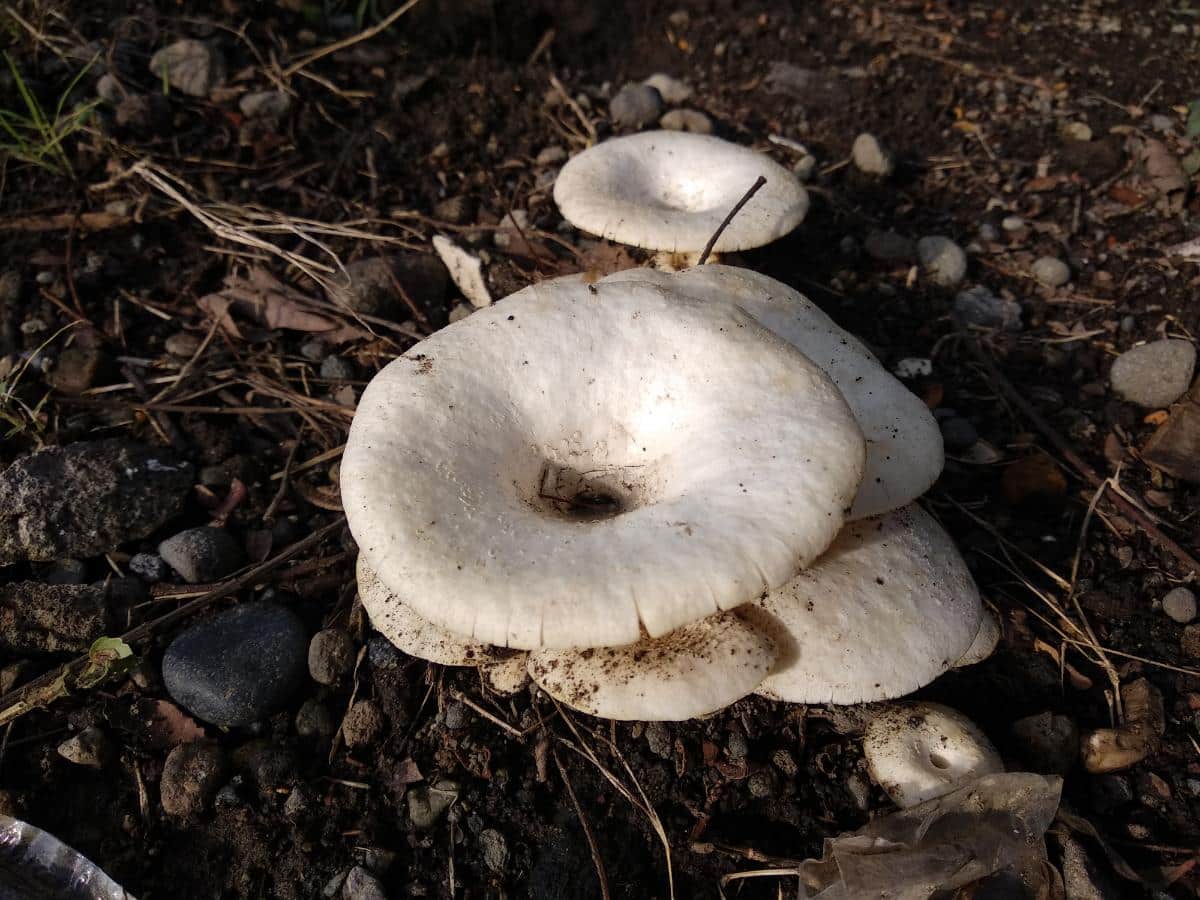
Leucopaxillus Mushroom Lookalikes
Telling apart Leucopaxillus from similar mushrooms requires attention to detail and an understanding of key differences. Many species are visually similar — there is no shortage of whitish-looking gilled mushrooms growing from the ground! Some of the other species are easy to differentiate, but a few are tricky.
Tricholoma Species
While Tricholoma species (like Matsutake) might resemble Leucopaxillus at first glance, you’ll notice some crucial differences. Tricholoma species are known for their relatively fragile nature and quick deterioration after being picked. This characteristic is one of the first things to note when trying to identify a Tricholoma mushroom.
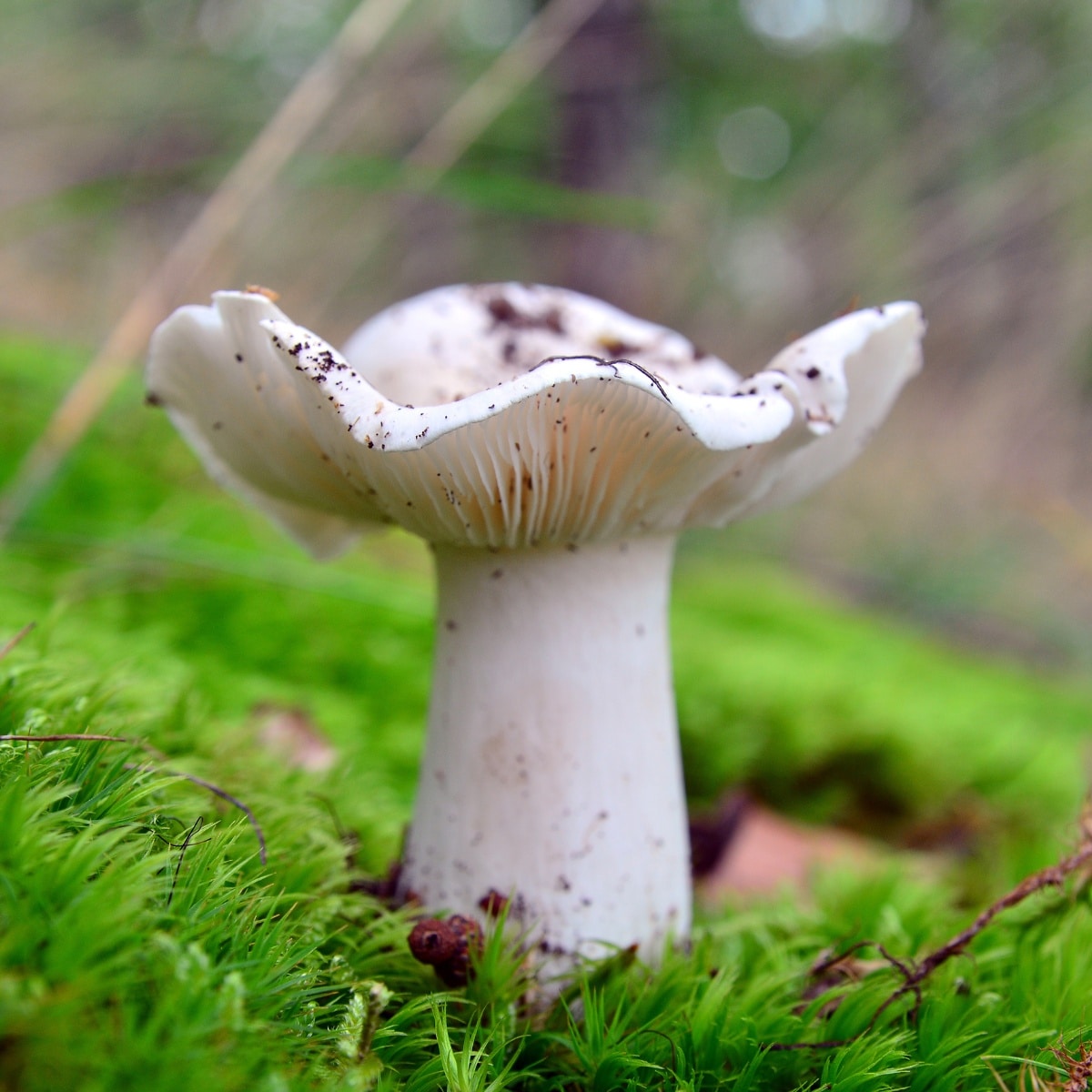
The caps of Tricholoma mushrooms are typically 1 to 6 inches in diameter, with a rounded to flat shape that may develop a slight depression in the center as they mature. They’re also white with whitish gills and grow on the ground. This is how most Leucopaxillus mushrooms grow as well.
The gill attachment is a key feature for telling these two apart. Tricholoma mushrooms have gills that are typically notched or sinuate where they meet the stem. This means there’s a noticeable indentation just before the gills attach to the stem. The gills are usually close together and can range in color from white to gray or even pinkish, depending on the species.
Leucopaxillus, on the other hand, has gills that are often decurrent, meaning they run down the stem for a short distance. This is a significant difference from the notched gills of Tricholoma. The gills of Leucopaxillus are usually white or cream-colored.
Habitat preferences can provide clues for identification. Many Tricholoma species form mycorrhizal associations with very specific trees. For example, they will only grow with one type of conifer tree. Leucopaxillus mushrooms, while also found in wooded areas, are more generalized.
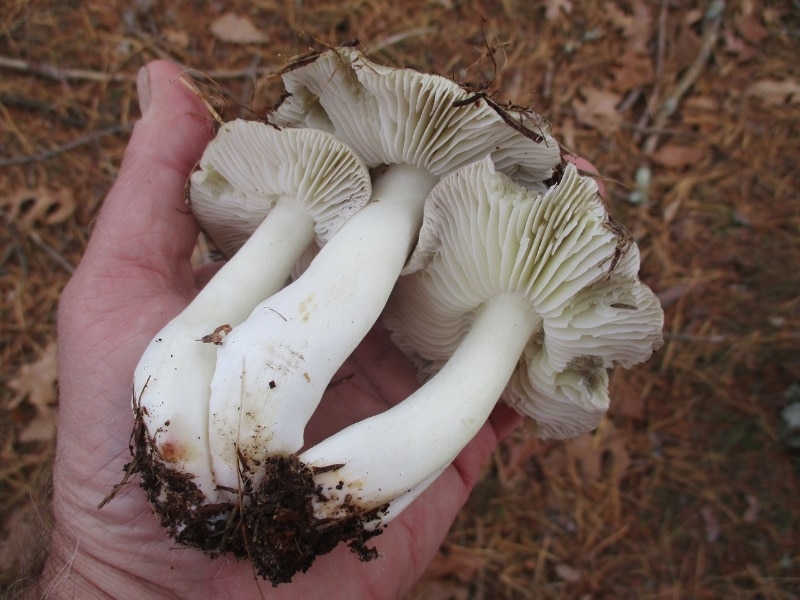
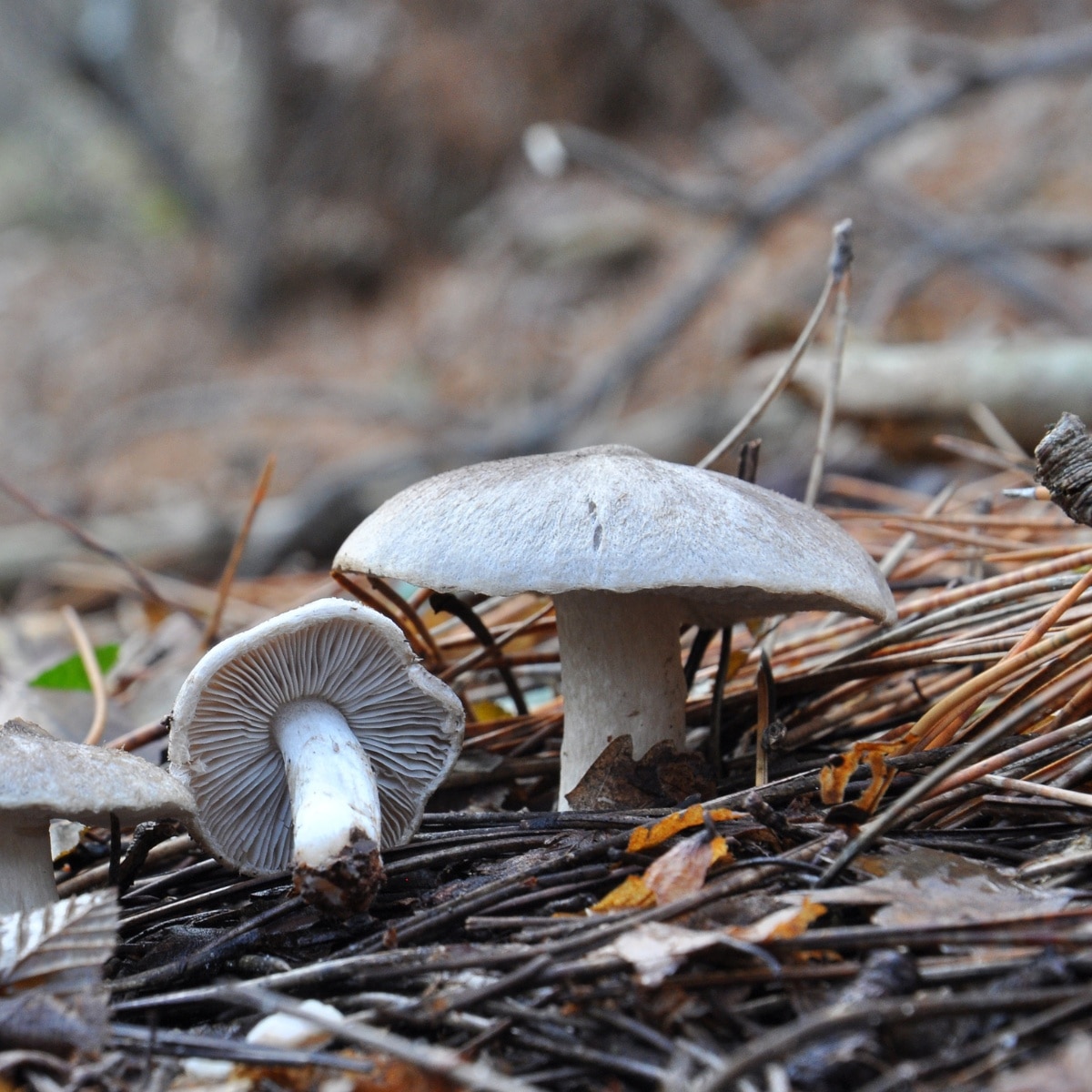
Clitocybe Species
Clitocybe mushrooms, like the fool’s funnel, look a lot like Leucopaxillus mushrooms. Not all Clitocybe species are dangerous, but the fool’s funnel is, so you need to be extra careful with this one. Clitocybe mushrooms are usually whitish and round, have white gills, and grow from the ground. Their gills also run down the stem, too, like Leucopaxillus. From above, it can be hard to tell Clitocybe apart from Leucopaxillus.
There is an easy test for distinguishing between Clitocybe and Leucopaxillus, though. If you were to gently toss the mushroom, the Clitocybe would break apart, while the Leucopaxillus would remain intact. Clitocybe species are more fragile and smaller; they rarely reach the impressive sizes of Leucopaxillus specimens.
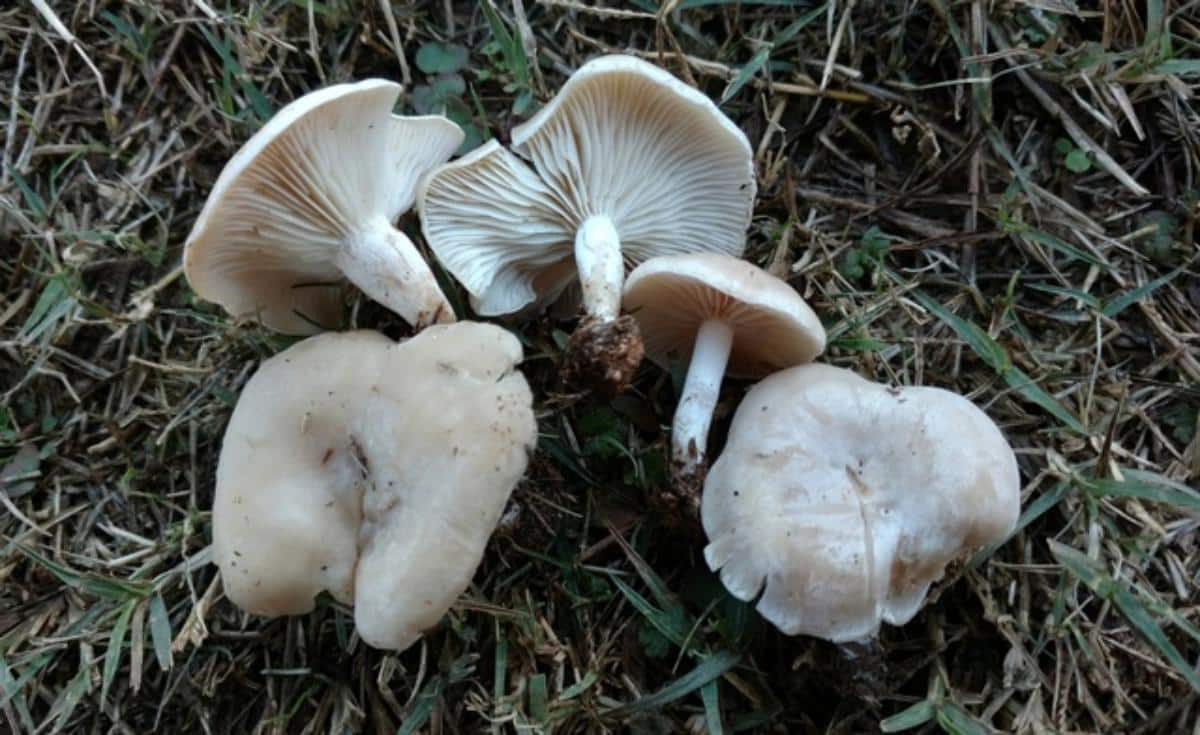
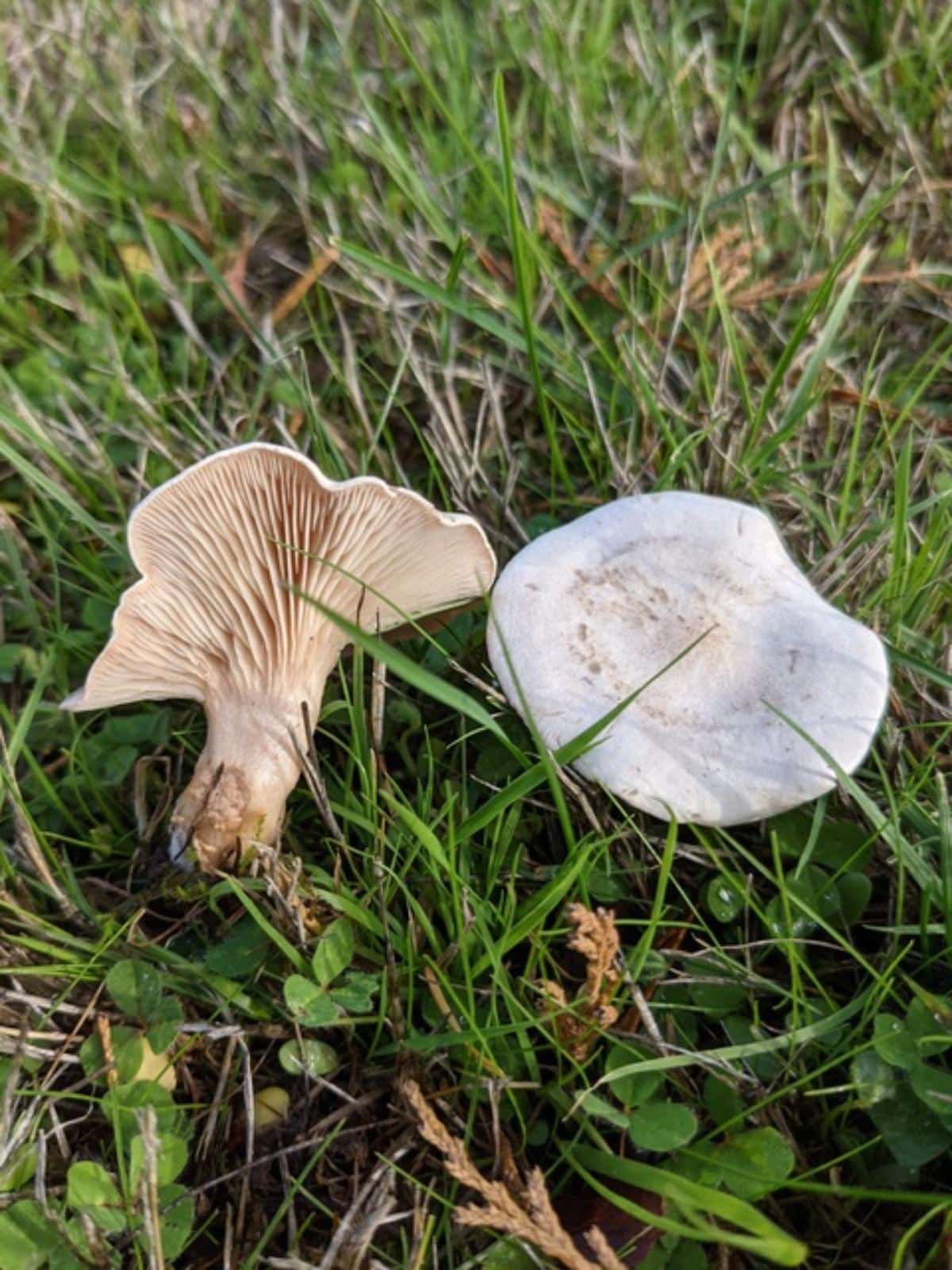
Russula Species
Russula species, known as brittlegills, have dense but fragile flesh. When you break the stem, it snaps easily, like chalk. This is an important way to identify them. Russula caps are usually 2 to 6 inches wide and come in many different colors, including red, purple, green, and yellow. Their gills are usually white to cream-colored and are attached to the stem but do not run down it.
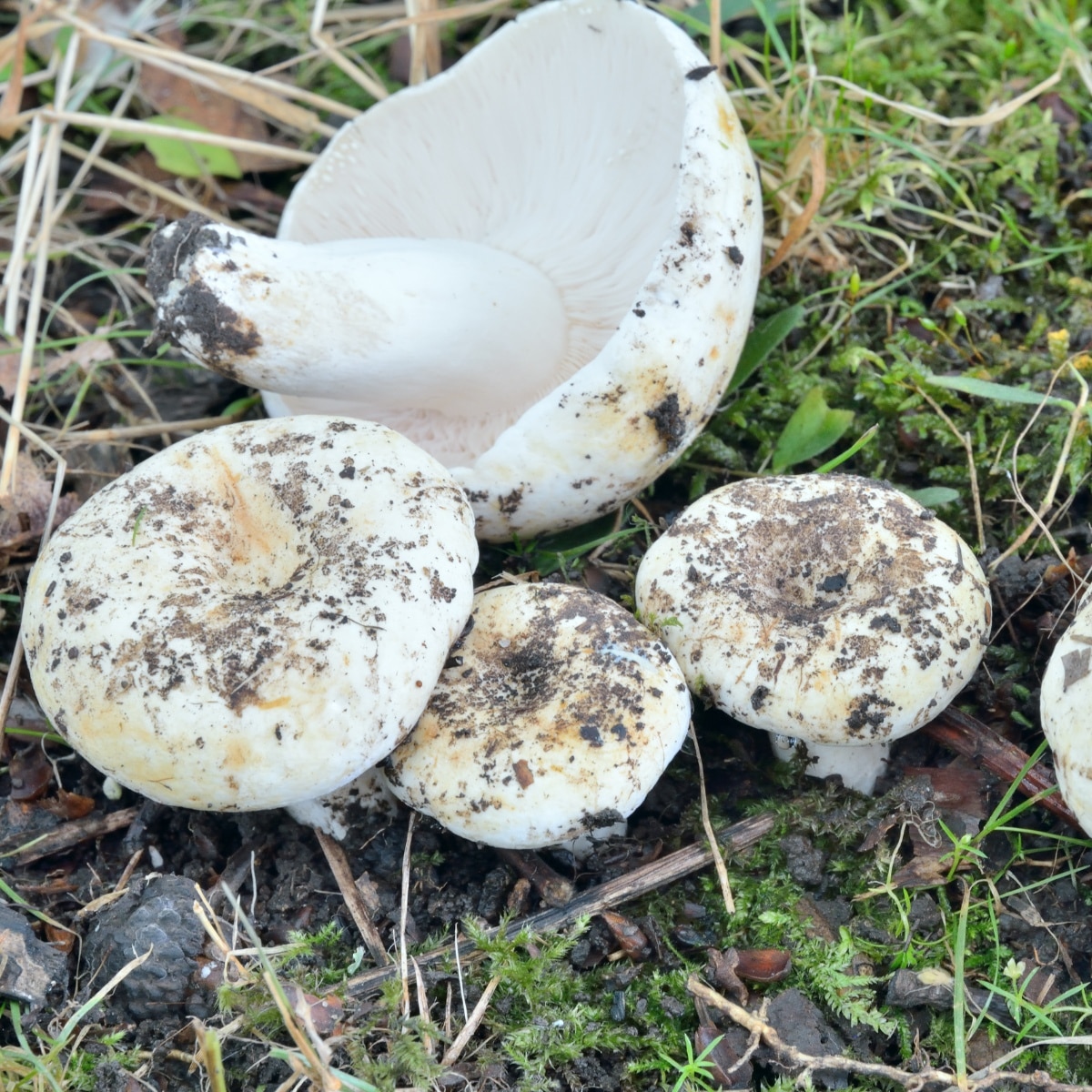
Leucopaxillus, on the other hand, are more robust. Unlike the brittle Russula, Leucopaxillus mushrooms have a fibrous texture that doesn’t snap easily. They are generally larger, with caps ranging from 2 to 12 inches in diameter. Leucopaxillus species typically have white to pale cream-colored caps, sometimes with a slight yellow or brown tinge. Their gills are decurrent (running down the stem) and can be close together or widely spaced, depending on the species.
Russula species are mycorrhizal, forming symbiotic relationships with trees, and are commonly found in woodlands. Leucopaxillus, while also found in wooded areas, are saprobic, meaning they decompose organic matter. They’re often found growing in clusters or rings on the forest floor.
Some Russula species are edible, many are not, and some can cause gastrointestinal distress.
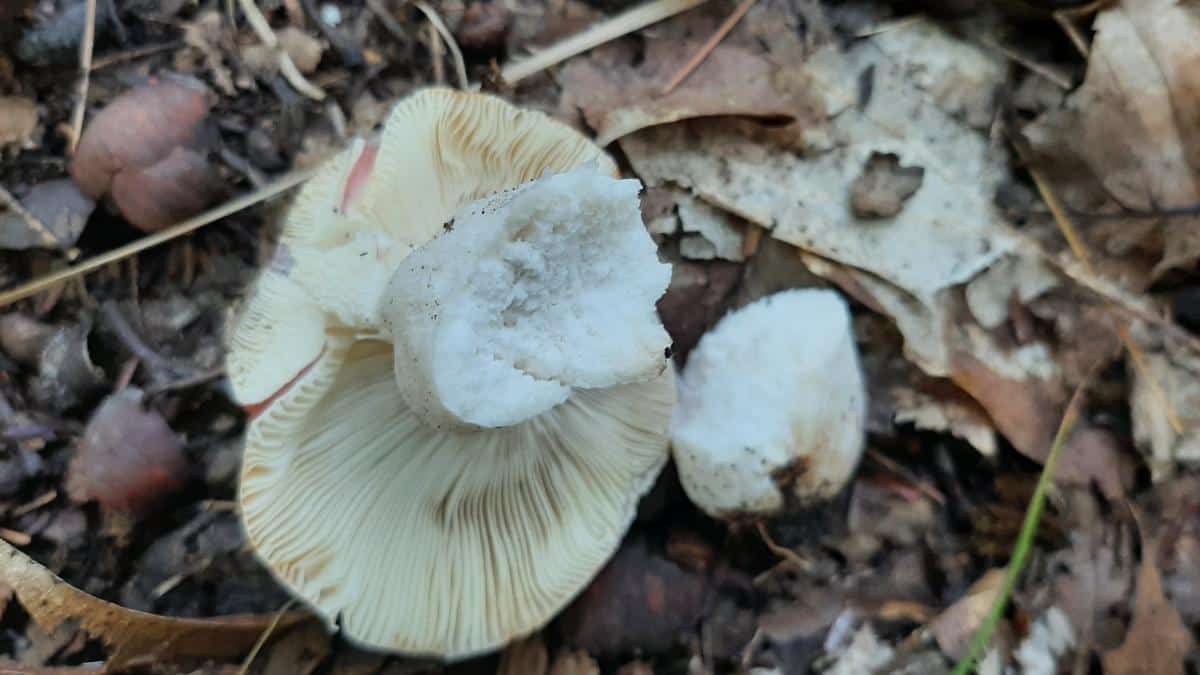
Milky Cap Species
Lactarius species (commonly known as Milk Caps) are most notable for their production of latex, or “milk,” when the flesh is cut or damaged. This is the primary feature that distinguishes them from Leucopaxillus and many other mushrooms. The latex can vary in color and may change color upon exposure to air. The consistency of this milk can range from watery to thick and sticky.
The gill attachment is another distinguishing feature. Lactarius species usually have gills that are attached to the stem (adnate) or run slightly down it (subdecurrent). In contrast, Leucopaxillus mushrooms typically have gills that run distinctly down the stem (decurrent). Lactarius stems are often more fragile and may be hollow or stuffed with a soft pith. Leucopaxillus stems tend to be more solid and fibrous, contributing to their robust appearance.
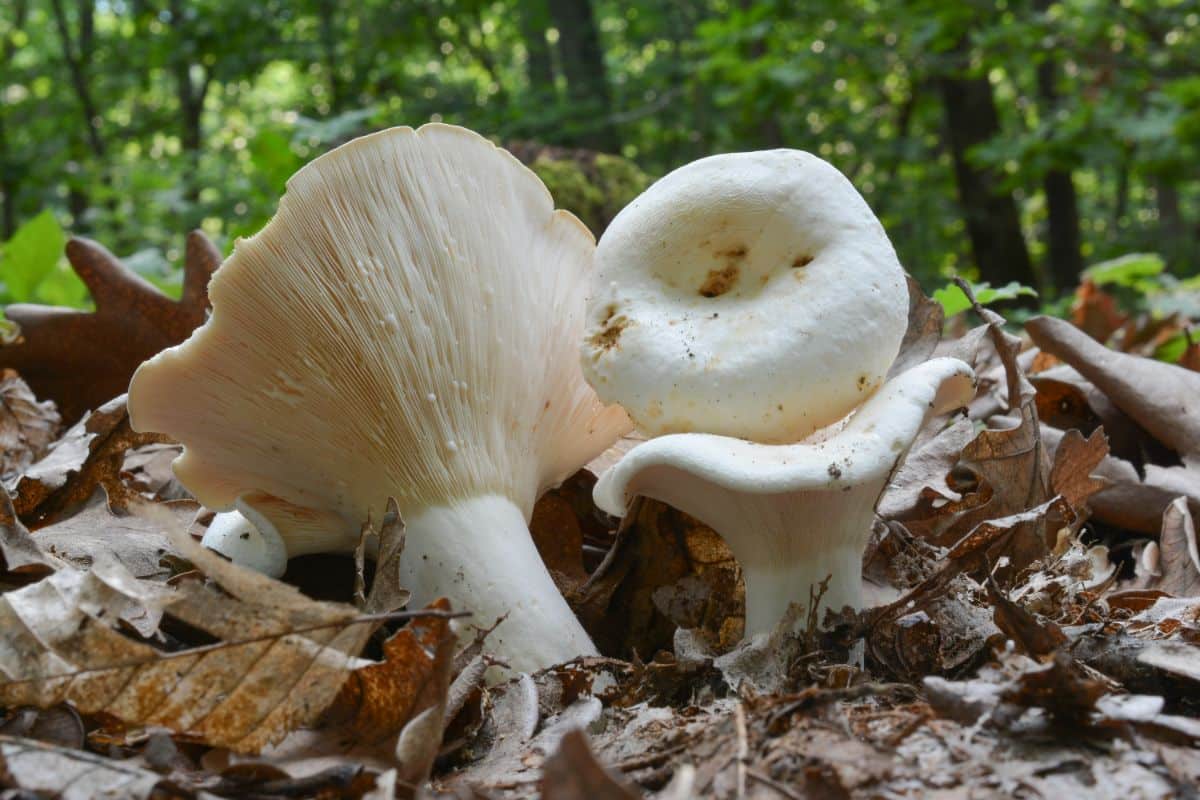
Edibility of Leucopaxillus Mushrooms
The edibility of Leucopaxillus mushrooms is generally considered to be poor to questionable. While all species are technically edible, they are often not foraged due to their bitter to bland taste and tough texture.
Leucopaxillus giganteus is foraged in some European communities. It is most commonly collected in rural areas where foraging is common. However, its collection is less widespread than other more popular edible mushrooms.
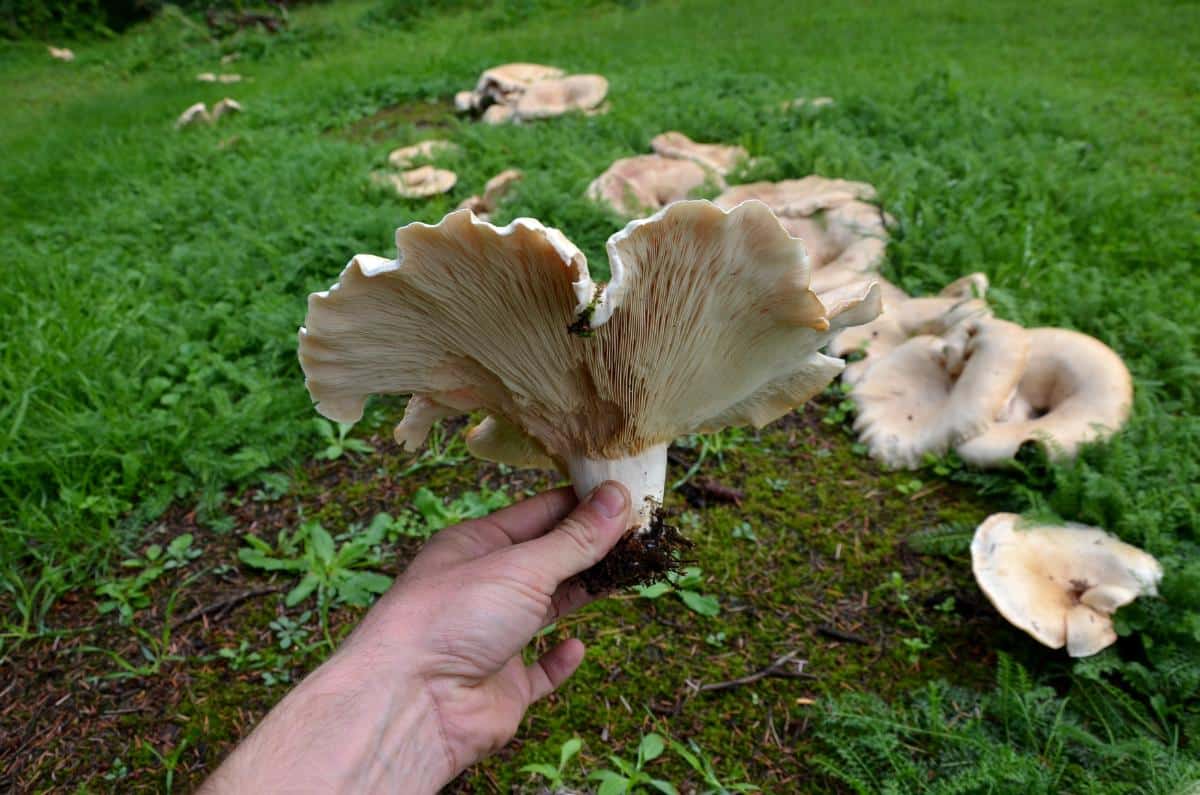
Preparation Techniques:
- Parboiling: This technique involves briefly boiling the mushrooms in water before discarding the liquid. This process can help reduce bitterness and improve texture.
- Cooking time: Edible Leucopaxillus mushrooms are tough and need longer cooking to taste good. It is often necessary to use slow cooking methods, like stewing or braising.
- Flavoring: These mushrooms can have a bitter taste, so they are usually cooked with strong flavors like garlic, onions, or herbs to enhance their taste.
- Drying: Some foragers dry the mushrooms to enhance their flavor and change their texture. After drying, they rehydrate the mushrooms and use them in soups or stews.
Medicinal Properties of Leucopaxillus Mushrooms
Certain Leucopaxillus species have gained attention for their potential health benefits. The giant leucopax is used in folk medicine in parts of Europe and North America. Traditional healers value it for its believed anti-inflammatory and antimicrobial effects.
The medicinal properties of Leucopaxillus mushrooms come from their active compounds. These mushrooms contain different polysaccharides, especially β-glucans, which may help the immune system. Some studies suggest these compounds can help the body fight infections.
Some studies have also indicated that extracts from Leucopaxillus giganteus have antioxidant properties. The presence of phenolic compounds and organic acids in these mushrooms contributes to their antioxidant capacity.
Research is looking into how Leucopaxillus species may be used in medicine, especially their ability to fight certain germs.
Further Reading:
- Bioactive properties of the medicinal mushroom Leucopaxillus giganteus mycelium obtained in the presence of different nitrogen sources
- Plant growth regulators and Axl and immune checkpoint inhibitors from the edible mushroom Leucopaxillus giganteus
- The structural characterization of a novel water‐soluble polysaccharide from edible mushroom Leucopaxillus giganteus and its antitumor activity on H22 tumor‐bearing mice
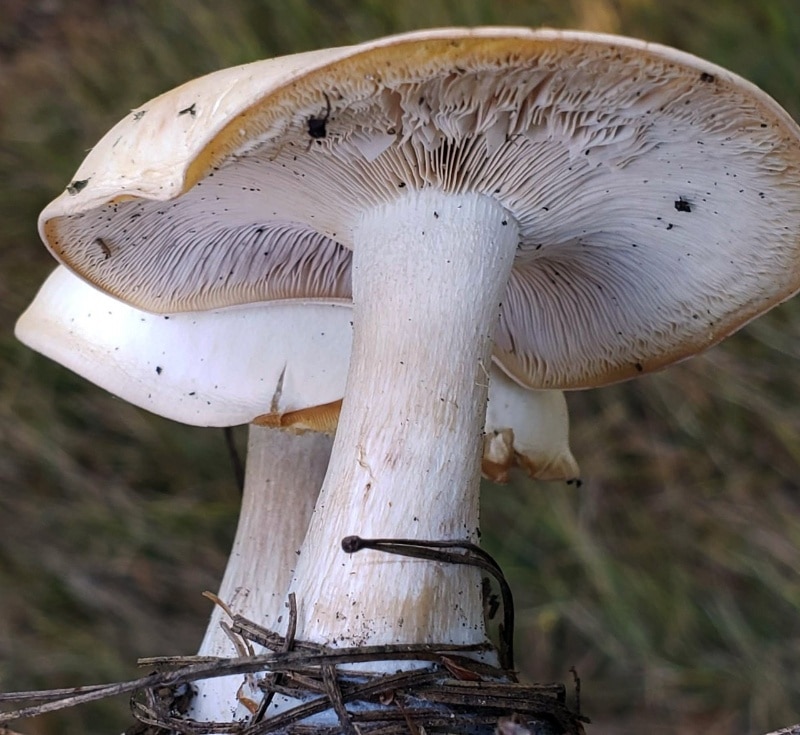
How Leucopaxillus Mushrooms Resist Decay
Leucopaxillus mushrooms have developed several mechanisms to resist decay. The first way starts with chitin. Chitin is a long-chain substance made of N-acetylglucosamine. It is a key part of fungal cell walls. In Leucopaxillus species, the chitin content is very high. This creates strong barriers that can resist breakdown by other microorganisms. Many species in this group have firm, compact flesh, making them less likely to suffer from physical damage. These chitin-rich cell walls help Leucopaxillus mushrooms resist decay.
They also produce specialized substances called secondary metabolites, including leucopaxillones and other bioactive molecules. These compounds have antimicrobial properties, which help stop the growth of bacteria and fungi that cause decay.
The fruiting bodies of Leucopaxillus mushrooms are also rich in melanin. This pigment not only gives some species their unique color but also protects them from environmental stress. Melanin acts as a strong antioxidant, fighting free radicals and reducing oxidative damage that can harm their cells and lead to decay.
Leucopaxillus species have also developed effective moisture management. Their cellular structure allows them to control their internal moisture levels. This prevents waterlogging, which can speed up decomposition in other mushrooms. By maintaining the right hydration, they significantly increase their lifespan and resistance to decay.
Common Questions About Leucopaxillus Mushrooms
What are the key features of Leucopaxillus mushrooms?
Leucopaxillus mushrooms can grow very large, reaching sizes up to 18 inches wide. When they are young, their caps are dry and smooth with edges that curl inward.
The gills are white to yellowish and can be easily separated as a complete layer from the cap. The stems are sturdy and have prominent white basal mycelium. These mushrooms also have a unique mealy or coal tar odor, and their flesh is tough and resists decay.
Are Leucopaxillus mushrooms edible?
While no species of Leucopaxillus are known to be poisonous, they are generally not considered desirable for consumption due to their unappealing taste and tough texture. Some species, like Leucopaxillus giganteus, are edible for most people but may cause gastric upset in others.
Are Leucopaxillus mushrooms poisonous?
Leucopaxillus mushrooms are not poisonous. However, they are not usually collected for the table due to their often offensive odor and lackluster taste.
Can I grow Leucopaxillus mushrooms?
Yes. Or maybe. Attempts have been made to grow Leucopaxillus mushrooms with mixed results. Recently, a group in Japan had good results growing Leucopaxillus giganteus in commercial pine forests.




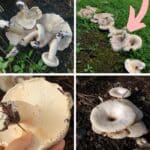
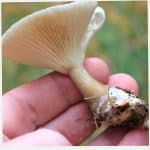

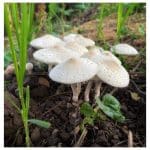
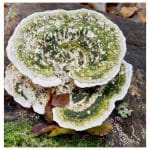
Leave a Reply